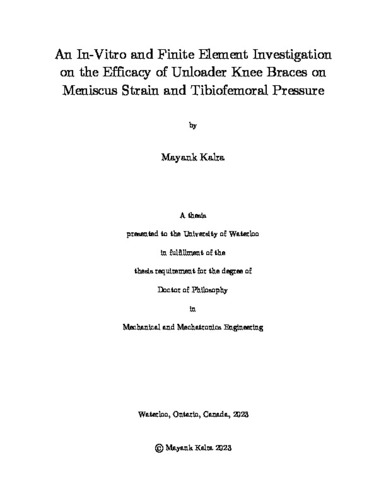UWSpace will be migrating to a new version of its software from July 29th to August 1st. UWSpace will be offline for all UW community members during this time.
An In-Vitro and Finite Element Investigation on the Efficacy of Unloader Knee Braces on Meniscus Strain and Tibiofemoral Pressure
| dc.contributor.author | Kalra, Mayank | |
| dc.date.accessioned | 2023-09-26 12:50:35 (GMT) | |
| dc.date.available | 2023-09-26 12:50:35 (GMT) | |
| dc.date.issued | 2023-09-26 | |
| dc.date.submitted | 2023-09-01 | |
| dc.identifier.uri | http://hdl.handle.net/10012/19942 | |
| dc.description.abstract | The medial and lateral menisci, situated in the knee joint, are most injured soft tissues in the human body. Meniscus injuries can be isolated or occur concurrently with an anterior cruciate ligament (ACL) injury. Certain tears are not amenable to surgical intervention and non-invasive treatment options such as unloader knee braces are theorized to benefit the knee joint during a medial meniscus injury. Unloader braces have shown favourable outcomes for medial osteoarthritis; however, there is a knowledge gap regarding the efficacy of these braces as an intervention for the meniscus. This study investigated the efficacy of two medial unloader braces (i.e., Rebound Cartilage and Unloader Fit) on the medial meniscus and tibiofemoral joint compartment during simulated activities of daily living (ADL) in healthy and injured ACL states. Posteromedial and anteromedial meniscus strains and tibiofemoral cartilage pressures were measured on cadaveric specimens (n=10) while replicating gait, double leg squats (DLS), and single leg squats (SLS) using a dynamic knee simulator. In a complementary study, the experimental boundary conditions were applied to a pre-existing 50th percentile male right leg finite element (FE) model and the three ADLs were simulated in both ACL states with a simulated 10 Nm valgus moment (VM) unloader brace effect. The computational approach investigated additional outcomes that could not be measured experimentally such as posterolateral meniscus strains. Descriptive statistics were calculated for experimental strain and pressure outcomes and an analysis of variance (ANOVA) was conducted. Descriptive statistics were calculated for FE strain and pressures, and a cross-correlation analysis (CORA) was performed to compare between the FE model and experiment. Both unloader braces resulted in significant reductions in mean and peak posteromedial meniscus strains during the ACL-intact state and significant differences in peak anteromedial meniscal strain (p<.05). Neither brace resulted in a significant difference in either strain outcome with an ACL deficiency (p>.05). There were no significant differences in tibial cartilage pressures with the application of both braces during the ACL-intact state (p>.05). Both braces resulted in an intended valgus unload during DLS and gait, though not during SLS despite reductions in posteromedial meniscus strain during SLS. Strain and pressure outcomes revealed that the RC brace significantly outperformed the UF brace (p<.05), as intended by the manufacturer, moreover, this was more noticeable in the ACL-deficient state. The FE simulations demonstrated strong kinematic validity (CORA=0.74–0.99) with the experiments and the simulated ADLs matched experimental behaviours with ACL-deficient and VM conditions. FE posteromedial meniscus strain outcomes were within the experimental corridors and strain and pressure outcomes were within 1–2 SD of the mean experimental outcomes. Posterolateral meniscus strains were 7-16% higher than posteromedial meniscus strains and helped demonstrate affirmative unloading mechanics when compared to the unbraced scenario. The VM approximated unloader brace mechanics as evidenced by strain and pressure increases in the lateral meniscus and cartilage, respectively, and demonstrated higher efficacy in the ACL-intact state over the -deficient state, similar to the experiment. This study addressed a major literature gap in knee brace biomechanics by quantifying the efficacy of two commercially available unloader braces on the medial meniscus and demonstrated the viability of a FE approach to measure deep tissue strain. Future research can consider these braces for clinical research in patients with a healthy ACL and the FE model or framework can be used to investigate a variable brace moment BC, additional ADLs, or injury states such as meniscectomies/osteoarthritis. | en |
| dc.language.iso | en | en |
| dc.publisher | University of Waterloo | en |
| dc.subject | meniscus strain | en |
| dc.subject | tibiofemoral cartilage pressure | en |
| dc.subject | in-vitro | en |
| dc.subject | cadaver | en |
| dc.subject | finite element | en |
| dc.subject | acl-deficient | en |
| dc.subject | medial unloader valgus knee brace | en |
| dc.title | An In-Vitro and Finite Element Investigation on the Efficacy of Unloader Knee Braces on Meniscus Strain and Tibiofemoral Pressure | en |
| dc.type | Doctoral Thesis | en |
| dc.pending | false | |
| uws-etd.degree.department | Mechanical and Mechatronics Engineering | en |
| uws-etd.degree.discipline | Mechanical Engineering | en |
| uws-etd.degree.grantor | University of Waterloo | en |
| uws-etd.degree | Doctor of Philosophy | en |
| uws-etd.embargo.terms | 0 | en |
| uws.contributor.advisor | Chandrashekar, Naveen | |
| uws.contributor.advisor | Cronin, Duane | |
| uws.contributor.affiliation1 | Faculty of Engineering | en |
| uws.published.city | Waterloo | en |
| uws.published.country | Canada | en |
| uws.published.province | Ontario | en |
| uws.typeOfResource | Text | en |
| uws.peerReviewStatus | Unreviewed | en |
| uws.scholarLevel | Graduate | en |

